1. Navon-Venezia S, Kondratyeva K, Carattoli A.
Klebsiella pneumoniae: a major worldwide source and shuttle for antibiotic resistance. FEMS Microbiol Rev. 2017; 41:252–275. PMID:
28521338.
2. Shon AS, Bajwa RPS, Russo TA. Hypervirulent (hypermucoviscous)
Klebsiella pneumoniae: a new and dangerous breed. Virulence. 2013; 4:107–118. PMID:
23302790.
3. Lee CR, Lee JH, Park KS, Jeon JH, Kim YB, Cha CJ, et al. Antimicrobial resistance of hypervirulent
Klebsiella pneumoniae: epidemiology, hypervirulence-associated determinants, and resistance mechanisms. Front Cell Infect Microbiol. 2017; 7:483. PMID:
29209595.
4. Russo TA, Olson R, MacDonald U, Beanan J, Davidson BA. Aerobactin, but not yersiniabactin, salmochelin, or enterobactin, enables the growth/survival of hypervirulent (hypermucoviscous) Klebsiella pneumoniae
ex vivo and
in vivo. Infect Immun. 2015; 83:3325–3333. PMID:
26056379.
5. Paczosa MK, Mecsas J.
Klebsiella pneumoniae: going on the offense with a strong defense. Microbiol Mol Biol Rev. 2016; 80:629–661. PMID:
27307579.
6. Chen L, Kreiswirth BN. Convergence of carbapenem-resistance and hypervirulence in
Klebsiella pneumoniae. Lancet Infect Dis. 2018; 18:2–3. PMID:
28864028.
7. Zhan L, Wang S, Guo Y, Jin Y, Duan J, Hao Z, et al. Outbreak by hypermucoviscous
Klebsiella pneumoniae ST11 isolates with carbapenem resistance in a tertiary hospital in China. Front Cell Infect Microbiol. 2017; 7:182. PMID:
28560183.
8. Gu D, Dong N, Zheng Z, Lin D, Huang M, Wang L, et al. A fatal outbreak of ST11 carbapenem-resistant hypervirulent
Klebsiella pneumoniae in a Chinese hospital: a molecular epidemiological study. Lancet Infect Dis. 2018; 18:37–46. PMID:
28864030.
9. Zhang R, Lin D, Chan EW, Gu D, Chen GX, Chen S. Emergence of carbapenem-resistant serotype K1 hypervirulent
Klebsiella pneumoniae strains in China. Antimicrob Agents Chemother. 2015; 60:709–711. PMID:
26574010.
10. Yao B, Xiao X, Wang F, Zhou L, Zhang X, Zhang J. Clinical and molecular characteristics of multi-clone carbapenem-resistant hypervirulent (hypermucoviscous)
Klebsiella pneumoniae isolates in a tertiary hospital in Beijing, China. Int J Infect Dis. 2015; 37:107–112. PMID:
26141415.
11. Arena F, Henrici De, D'Andrea MM, Cannatelli A, Fossati L, Di Pilato V, et al. Infections caused by carbapenem-resistant
Klebsiella pneumoniae with hypermucoviscous phenotype: a case report and literature review. Virulence. 2017; 8:1900–1908. PMID:
28276993.
12. Shankar C, Nabarro LE, Devanga Ragupathi NK, Muthuirulandi Sethuvel DP, Daniel JL, Doss C GP, et al. Draft genome sequences of three hypervirulent carbapenem-resistant Klebsiella pneumoniae isolates from bacteremia. Genome Announc. 2016; 4:pii: e01081-16.
13. CLSI. CLSI supplement M100. Performance standards for antimicrobial susceptibility testing. 28th ed. Wayne, PA: Clinical and Laboratory Standards Institute;2018.
14. CLSI. CLSI Standard M07. Methods for dilution antimicrobial susceptibility tests for bacteria that grow aerobically. 11th ed. Wayne, PA: Clinical and Laboratory Standards Institute;2018.
15. The European Committee on Antimicrobial Susceptibility Testing. Breakpoint tables for interpretation of MICs and zone diameters. Version 7.0. 2017. Updated on Jan 2017.
http://www.eucast.org.
16. Galani I, Rekatsina PD, Hatzaki D, Plachouras D, Souli M, Giamarellou H. Evaluation of different laboratory tests for the detection of metallo-beta-lactamase production in
Enterobacteriaceae. J Antimicrob Chemother. 2008; 61:548–553. PMID:
18222954.
17. Doyle D, Peirano G, Lascols C, Lloyd T, Church DL, Pitout JD. Laboratory detection of
Enterobacteriaceae that produce carbapenemases. J Clin Microbiol. 2012; 50:3877–3880. PMID:
22993175.
18. Yan J, Pu S, Jia X, Xu X, Yang S, Shi J, et al. Multidrug resistance mechanisms of carbapenem resistant
Klebsiella pneumoniae strains isolated in Chongqing, China. Ann Lab Med. 2017; 37:398–407. PMID:
28643488.
19. Brisse S, Passet V, Haugaard AB, Babosan A, Kassis-Chikhani N, Struve C, et al. wzi Gene sequencing, a rapid method for determination of capsular type for
Klebsiella strains. J Clin Microbiol. 2013; 51:4073–4078. PMID:
24088853.
20. Pan YJ, Lin TL, Chen YH, Hsu CR, Hsieh PF, Wu MC, et al. Capsular types of
Klebsiella pneumoniae revisited by wzc sequencing. PLoS One. 2013; 8:e80670. PMID:
24349011.
21. Liu Y, Liu PP, Wang LH, Wei DD, Wan LG, Zhang W. Capsular polysaccharide types and virulence-related traits of epidemic KPC-producing
Klebsiella pneumoniae isolates in a Chinese university Hospital. Microb Drug Resist. 2017; 23:901–907. PMID:
28437231.
22. Yan Q, Zhou M, Zou M, Liu WE. Hypervirulent
Klebsiella pneumoniae induced ventilator-associated pneumonia in mechanically ventilated patients in China. Eur J Clin Microbiol Infect Dis. 2016; 35:387–396. PMID:
26753990.
23. Diancourt L, Passet V, Verhoef J, Grimont PA, Brisse S. Multilocus sequence typing of
Klebsiella pneumoniae nosocomial isolates. J Clin Microbiol. 2005; 43:4178–4182. PMID:
16081970.
24. Chiang TT, Yang YS, Yeh KM, Chiu SK, Wang NC, Lin TY, et al. Quantification and comparison of virulence and characteristics of different variants of carbapenemase-producing
Klebsiella pneumoniae clinical isolates from Taiwan and the United States. J Microbiol Immunol Infect. 2016; 49:83–90. PMID:
26514941.
25. Mclaughlin MM, Advincula MR, Malczynski M, Barajas G, Qi C, Scheetz MH. Quantifying the clinical virulence of
Klebsiella pneumoniae producing carbapenemase
Klebsiella pneumoniae with a
Galleria mellonella model and a pilot study to translate to patient outcomes. BMC Infect Dis. 2014; 14:31. PMID:
24428847.
26. Horan TC, Andrus M, Dudeck MA. CDC/NHSN surveillance definition of health care-associated infection and criteria for specific types of infections in the acute care setting. Am J Infect Control. 2008; 36:309–332. PMID:
18538699.
27. Lee CR, Lee JH, Park KS, Kim YB, Jeong BC, Lee SH. Global dissemination of carbapenemase-producing
Klebsiella pneumoniae: epidemiology, genetic context, treatment options, and detection methods. Front Microbiol. 2016; 7:895. PMID:
27379038.
28. Mei YF, Liu PP, Wan LG, Liu Y, Wang LH, Wei DD, et al. Virulence and genomic feature of a virulent
Klebsiella pneumoniae sequence Type 14 strain of serotype K2 harboring
blaNDM-5 in China. Front Microbiol. 2017; 8:335. PMID:
28386246.
29. Compain F, Vandenberghe A, Gominet M, Genel N, Lebeaux D, Ramahefasolo A, et al. Primary osteomyelitis caused by an NDM-1-producing
K. pneumoniae strain of the highly virulent sequence type 23. Emerg Microbes Infect. 2017; 6:e57. PMID:
28634354.
30. Wei DD, Wan LG, Liu Y. Draft genome sequence of an NDM-1- and KPC-2-coproducing hypervirulent carbapenem-resistant Klebsiella pneumoniae strain isolated from burn wound infections. Genome Announc. 2018; 6:pii: e00192-18.
31. Qi Y, Wei Z, Ji S, Du X, Shen P, Yu Y. ST11, the dominant clone of KPC-producing
Klebsiella pneumoniae in China. J Antimicrob Chemother. 2011; 66:307–312. PMID:
21131324.
32. Fang CT, Lai SY, Yi WC, Hsueh PR, Liu KL. The function of
wzy_K1 (magA), the serotype K1 polymerase gene in
Klebsiella pneumoniae cps gene cluster. J Infect Dis. 2010; 201:1268–1269. PMID:
20225957.
33. Liu YM, Li BB, Zhang YY, Zhang W, Shen H, Li H, et al. Clinical and molecular characteristics of emerging hypervirulent
Klebsiella pneumoniae bloodstream infections in mainland China. Antimicrob Agents Chemother. 2014; 58:5379–5385. PMID:
24982067.
34. Sun Y, Wu H, Shen D. Clinical and molecular analysis of
Klebsiella pneumoniae causing liver abscess in China. J Mol Microbiol Biotechnol. 2016; 26:245–251. PMID:
27073997.
35. Russo TA, Olson R, Macdonald U, Metzger D, Maltese LM, Drake EJ, et al. Aerobactin mediates virulence and accounts for increased siderophore production under iron-limiting conditions by hypervirulent (hypermucoviscous)
Klebsiella pneumoniae. Infect Immun. 2014; 82:2356–2367. PMID:
24664504.
36. Wand ME, McCowen JW, Nugent PG, Sutton JM. Complex interactions of
Klebsiella pneumoniae with the host immune system in a Galleria mellonella infection model. J Med Microbiol. 2013; 62:1790–1798. PMID:
24000226.
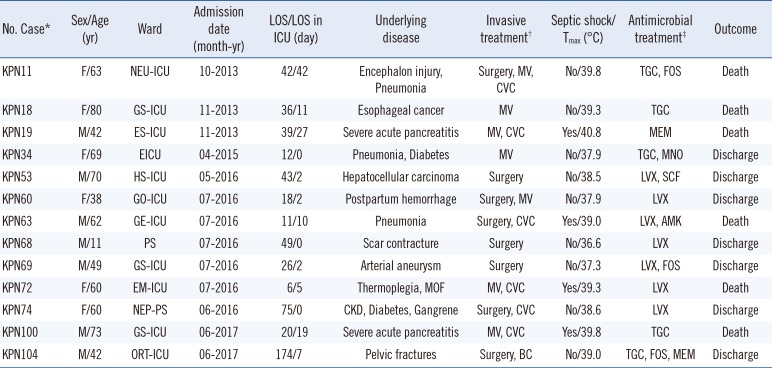
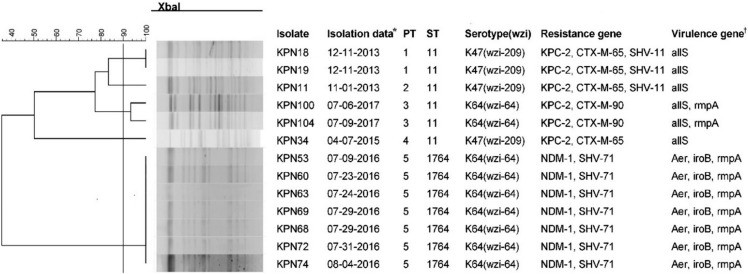
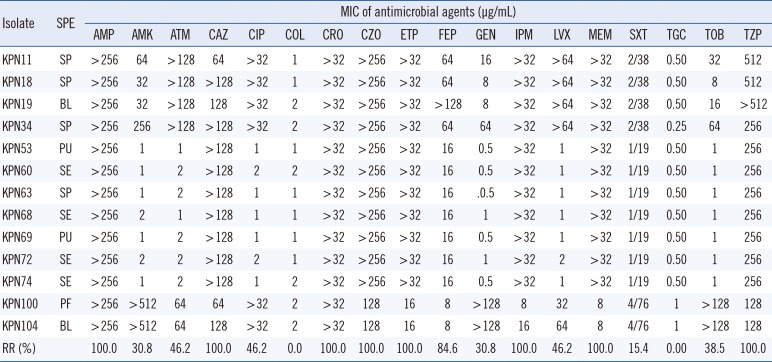
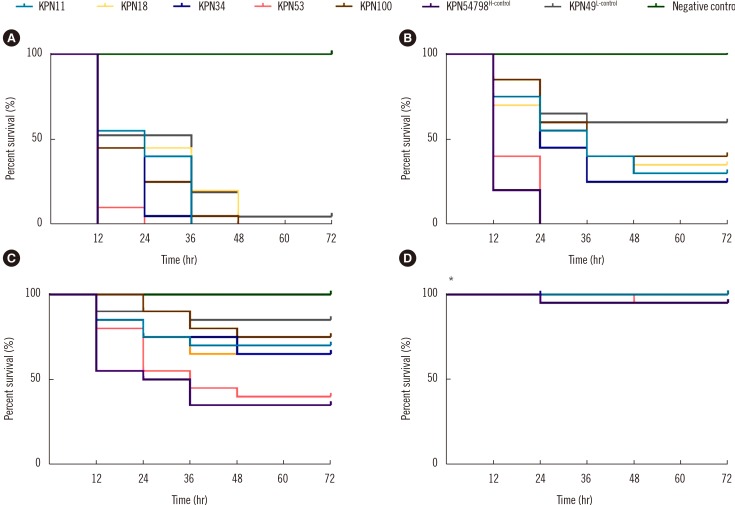
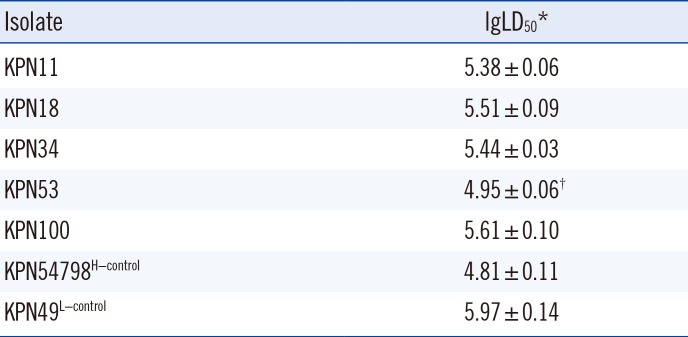




 PDF
PDF ePub
ePub Citation
Citation Print
Print



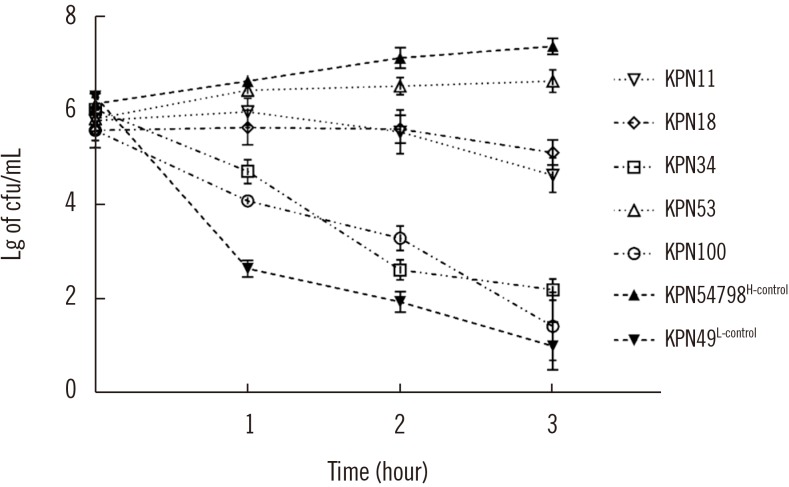
 XML Download
XML Download